formerly eScholarship Editions


|
|
|
|
Your request for similar items found 20 book(s). | Modify Search | Displaying 1 - 20 of 20 book(s) | |
| 1. | 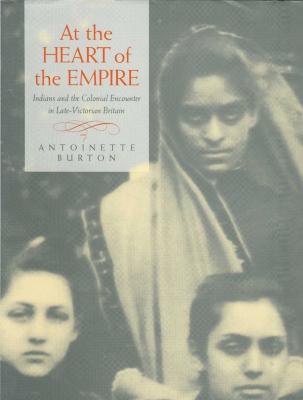 | Title: At the heart of the Empire: Indians and the colonial encounter in late-Victorian Britain Author: Burton, Antoinette M 1961- Published: University of California Press, 1998 Subjects: History | Women's Studies | Autobiographies and Biographies | South Asia | Victorian History | Travel | European History | Asian History Publisher's Description: Antoinette Burton focuses on the experiences of three Victorian travelers in Britain to illustrate how "Englishness" was made and remade in relation to imperialism. The accounts left by these three sojourners - all prominent, educated Indians - represent complex, critical ethnographies of "native" metropolitan society and offer revealing glimpses of what it was like to be a colonial subject in fin-de-siècle Britain. Burton's innovative interpretation of the travelers' testimonies shatters the myth of Britain's insularity from its own construction of empire and shows that it was instead a terrain open to continual contest and refiguration.Burton's three subjects felt the influence of imperial power keenly during even the most everyday encounters in Britain. Pandita Ramabai arrived in London in 1883 seeking a medical education and left in 1886, having resisted the Anglican Church's attempts to make her an evangelical missionary. Cornelia Sorabji went to Oxford to study law and became the first Indian woman to be called to the Bar. Behramji Malabari sought help for his Indian reform projects in England, and subjected London to colonial scrutiny in the process. Their experiences form the basis of this wide-ranging, clearly written, and imaginative investigation of diasporic movement in the colonial metropolis. [brief] Similar Items |
| 2. | 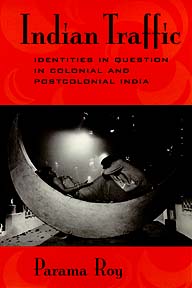 | Title: Indian traffic: identities in question in colonial and postcolonial India Author: Roy, Parama Published: University of California Press, 1998 Subjects: Postcolonial Studies | Literary Theory and Criticism | South Asia | Gender Studies Publisher's Description: The continual, unpredictable, and often violent "traffic" between identities in colonial and postcolonial India is the focus of Parama Roy's stimulating and original book. Mimicry has been commonly recognized as an important colonial model of bourgeois/elite subject formation, and Roy examines its place in the exchanges between South Asian and British, Hindu and Muslim, female and male, and subaltern and elite actors. Roy draws on a variety of sources - religious texts, novels, travelogues, colonial archival documents, and films - making her book genuinely interdisciplinary. She explores the ways in which questions of originality and impersonation function, not just for "western" or "westernized" subjects, but across a range of identities. For example, Roy considers the Englishman's fascination with "going native," an Irishwoman's assumption of Hindu feminine celibacy, Gandhi's impersonation of femininity, and a Muslim actress's emulation of a Hindu/Indian mother goddess. Familiar works by Richard Burton and Kipling are given fresh treatment, as are topics such as the "muscular Hinduism" of Swami Vivekananda. Indian Traffic demonstrates that questions of originality and impersonation are in the forefront of both the colonial and the nationalist discourses of South Asia and are central to the conceptual identity of South Asian postcolonial theory itself. [brief] Similar Items |
| 3. | 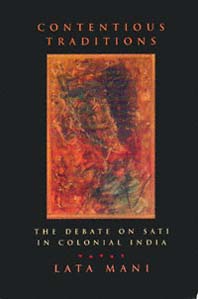 | Title: Contentious traditions: the debate on Sati in colonial India Author: Mani, Lata 1956- Published: University of California Press, 1998 Subjects: History | South Asia | Postcolonial Studies Publisher's Description: Contentious Traditions analyzes the debate on sati , or widow burning, in colonial India. Though the prohibition of widow burning in 1829 was heralded as a key step forward for women's emancipation in modern India, Lata Mani argues that the women who were burned were marginal to the debate and that the controversy was over definitions of Hindu tradition, the place of ritual in religious worship, the civilizing missions of colonialism and evangelism, and the proper role of the colonial state. Mani radically revises colonialist as well as nationalist historiography on the social reform of women's status in the colonial period and clarifies the complex and contradictory character of missionary writings on India.The history of widow burning is one of paradox. While the chief players in the debate argued over the religious basis of sati and the fine points of scriptural interpretation, the testimonials of women at the funeral pyres consistently addressed the material hardships and societal expectations attached to widowhood. And although historiography has traditionally emphasized the colonial horror of sati , a fascinated ambivalence toward the practice suffused official discussions. The debate normalized the violence of sati and supported the misconception that it was a voluntary act of wifely devotion.Mani brilliantly illustrates how situated feminism and discourse analysis compel a rewriting of history, thus destabilizing the ways we are accustomed to look at women and men, at "tradition," custom, and modernity. [brief] Similar Items |
| 4. | 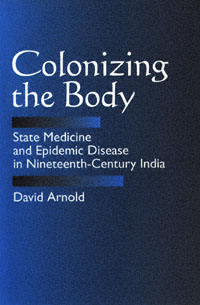 | Title: Colonizing the body: state medicine and epidemic disease in nineteenth-century India Author: Arnold, David 1946- Published: University of California Press, 1993 Subjects: Asian Studies | South Asia | Asian History | Medicine | History Publisher's Description: In this innovative analysis of medicine and disease in colonial India, David Arnold explores the vital role of the state in medical and public health activities, arguing that Western medicine became a critical battleground between the colonized and the colonizers.Focusing on three major epidemic diseases - smallpox, cholera, and plague - Arnold analyzes the impact of medical interventionism. He demonstrates that Western medicine as practiced in India was not simply transferred from West to East, but was also fashioned in response to local needs and Indian conditions.By emphasizing this colonial dimension of medicine, Arnold highlights the centrality of the body to political authority in British India and shows how medicine both influenced and articulated the intrinsic contradictions of colonial rule. [brief] Similar Items |
| 5. | 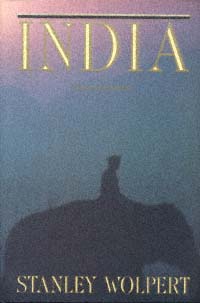 | Title: India Author: Wolpert, Stanley A 1927- Published: University of California Press, 1990 Subjects: History | South Asia | Asian History Publisher's Description: The history of India is the engrossing story of an ancient civilization, reborn as a modern nation. More a continent than a single nation, India is home to over one-fifth of humanity, yet it remains a mystery to most non-Indians, barely appreciated and poorly understood. Stanley Wolpert's India provides a much-needed, concise overview of Indian history and culture. His new preface brings the book up to date, discussing national elections, the economic effects of the new globalization, and the consequences of joining the nuclear arms race. [brief] Similar Items |
| 6. | 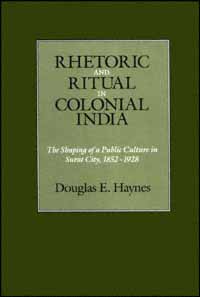 | Title: Rhetoric and ritual in colonial India: the shaping of a public culture in Surat City, 1852-1928 Author: Haynes, Douglas E Published: University of California Press, 1991 Subjects: History | Asian History | South Asia | Cultural Anthropology Publisher's Description: This book explores the rhetoric and ritual of Indian elites undercolonialism, focusing on the city of Surat in the Bombay Presidency. It particularly examines how local elites appropriated and modified the liberal representative discourse of Britain and thus fashioned a "public' culture that excluded the city's underclasses. Departing from traditional explanations that have seen this process as resulting from English education or radical transformations in society, Haynes emphasizes the importance of the unequal power relationship between the British and those Indians who struggled for political influence and justice within the colonial framework. A major contribution of the book is Haynes' analysis of the emergence and ultimate failure of Ghandian cultural meanings in Indian politics after 1923.The book addresses issues of importance to historians and anthropologists of India, to political scientists seeking to understand the origins of democracy in the "Third World," and general readers interested in comprehending processes of cultural change in colonial contexts. [brief] Similar Items |
| 7. | 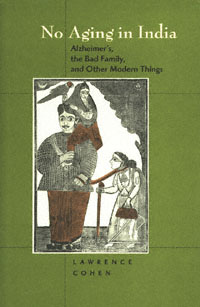 | Title: No aging in India: Alzheimer's, the bad family, and other modern things Author: Cohen, Lawrence 1961- Published: University of California Press, 1998 Subjects: Anthropology | Medical Anthropology | Aging | South Asia Publisher's Description: From the opening sequence, in which mid-nineteenth-century Indian fishermen hear the possibility of redemption in an old woman's madness, No Aging in India captures the reader with its interplay of story and analysis. Drawing on more than a decade of ethnographic work, Lawrence Cohen links a detailed investigation of mind and body in old age in four neighborhoods of the Indian city of Varanasi (Banaras) with events and processes around India and around the world. This compelling exploration of senility - encompassing not only the aging body but also larger cultural anxieties - combines insights from medical anthropology, psychoanalysis, and postcolonial studies. Bridging literary genres as well as geographic spaces, Cohen responds to what he sees as the impoverishment of both North American and Indian gerontologies - the one mired in ambivalence toward demented old bodies, the other insistent on a dubious morality tale of modern families breaking up and abandoning their elderly. He shifts our attention irresistibly toward how old age comes to matter in the constitution of societies and their narratives of identity and history. [brief] Similar Items |
| 8. | 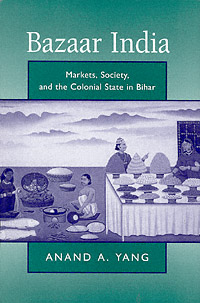 | Title: Bazaar India: markets, society, and the colonial state in Gangetic Bihar Author: Yang, Anand A Published: University of California Press, 1999 Subjects: Asian Studies | South Asia | Asian History | Economics and Business Publisher's Description: The role of markets in linking local communities to larger networks of commerce, culture, and political power is the central element in Anand A. Yang's provocative and original study. Yang uses bazaars in the northeast Indian state of Bihar during the colonial period as the site of his investigation. The bazaar provides a distinctive locale for posing fundamental questions regarding indigenous societies under colonialism and for highlighting less familiar aspects of colonial India.At one level, Yang reconstructs Bihar's marketing system, from its central place in the city of Patna down to the lowest rung of the periodic markets. But he also concentrates on the dynamics of exchanges and negotiations between different groups and on what can be learned through the "voices" of people in the bazaar: landholders, peasants, traders, and merchants. Along the way, Yang uncovers a wealth of details on the functioning of rural trade, markets, fairs, and pilgrimages in Bihar.A key contribution of Bazaar India is its many-stranded narrative history of some of South Asia's primary actors over the past two centuries. But Yang's approach is not that of a detached observer; rather, his own voice is engaged with the voices of the past and with present-day historians. By focusing on the world beyond the mud walls of the village, he widens the imaginative geography of South Asian history. Readers with an interest in markets, social history, culture, colonialism, British India, and historiographic methods will welcome his book. [brief] Similar Items |
| 9. | 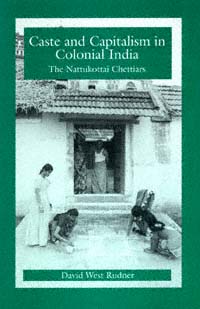 | Title: Caste and capitalism in colonial India: the Nattukottai Chettiars Author: Rudner, David West Published: University of California Press, 1994 Subjects: Anthropology | Cultural Anthropology | South Asia | Asian History Publisher's Description: David Rudner's richly detailed ethnographic and historical analysis of a South Indian merchant-banking caste provides the first comprehensive analysis of the interdependence among Indian business practice, social organization, and religion. Exploring noncapitalist economic formations and the impact of colonial rule on indigenous commercial systems, Rudner argues that caste and commerce are inextricably linked through formal and informal institutions. The practices crucial to the formation and distribution of capital are also a part of this linkage. Rudner challenges the widely held assumptions that all castes are organized either by marriage alliance or status hierarchy and that caste structures are incompatible with the "rational" conduct of business. [brief] Similar Items |
| 10. | 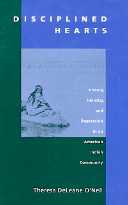 | Title: Disciplined hearts: history, identity, and depression in an American Indian community Author: O'Nell, Theresa DeLeane 1957- Published: University of California Press, 1996 Subjects: Anthropology | Folklore and Mythology | Native American Ethnicity | Native American Studies Publisher's Description: "This is a good place for your work. Depression is a big problem here. About 70-80% of our people are depressed." When she arrived at the Flathead Reservation in Montana to start an ethnographic study of depression, medical anthropologist Theresa DeLeane O'Nell repeatedly encountered such statements. This astonishingly widespread concern propelled the author into the complex lives of these modern American Indian people and into the historical roots of their contemporary situation.In Disciplined Hearts, O'Nell draws on recent anthropological theory to locate Flathead depression in the culturally organized experiences of an oppressed people. According to O'Nell, Flathead narratives of depression are tales in which narrators use their demoralization as a guide for modern Indian life. Underlying their tales, she says, is the dramatic assertion that depression is the natural condition of "real Indians" - those who have "disciplined" their hearts by recasting their personal sadness into compassion for others.This rich account of family and community life describes the moral imagination with which Flathead Indian people weave together historical and personal loss, American Indian identity, and social responsibility. Based on her ethnographic and clinical work, O'Nell pinpoints American Indian depression within a complex interplay of cultural ideas of the self and the Indian family, emotion and ethnic identity, and historical relations between Indians and whites. [brief] Similar Items |
| 11. | 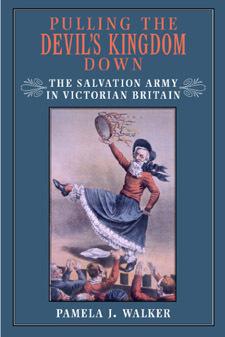 | Title: Pulling the devil's kingdom down: the Salvation Army in Victorian Britain Author: Walker, Pamela J 1960- Published: University of California Press, 2001 Subjects: History | Christianity | Victorian History | Religion | Women's Studies Publisher's Description: Those people in uniforms who ring bells and raise money for the poor during the holiday season belong to a religious movement that in 1865 combined early feminism, street preaching, holiness theology, and intentionally outrageous singing into what soon became the Salvation Army. In Pulling the Devil's Kingdom Down, Pamela Walker emphasizes how thoroughly the Army entered into nineteenth-century urban life. She follows the movement from its Methodist roots and East London origins through its struggles with the established denominations of England, problems with the law and the media, and public manifestations that included street brawls with working-class toughs. The Salvation Army was a neighborhood religion, with a "battle plan" especially suited to urban working-class geography and cultural life. The ability to use popular leisure activities as inspiration was a major factor in the Army's success, since pubs, music halls, sports, and betting were regarded as its principal rivals. Salvationist women claimed the "right to preach" and enjoyed spiritual authority and public visibility more extensively than in virtually any other religious or secular organization. Opposition to the new movement was equally energetic and took many forms, but even as contemporary music hall performers ridiculed the "Hallelujah Lasses," the Salvation Army was spreading across Great Britain and the Continent, and on to North America. The Army offered a distinctive response to the dilemmas facing Victorian Christians, in particular the relationship between what Salvationists believed and the work they did. Walker fills in the social, cultural, and religious contexts that make that relationship come to life. [brief] Similar Items |
| 12. | 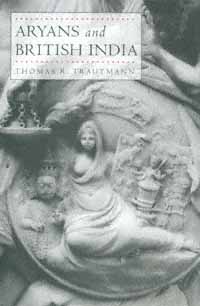 | Title: Aryans and British India Author: Trautmann, Thomas R Published: University of California Press, 1997 Subjects: History | South Asia | Asian History | European History Publisher's Description: "Aryan," a word that today evokes images of racial hatred and atrocity, was first used by Europeans to suggest bonds of kinship, as Thomas Trautmann shows in his far-reaching history of British Orientalism and the ethnology of India. When the historical relationship uniting Sanskrit with the languages of Europe was discovered, it seemed clear that Indians and Britons belonged to the same family. Thus the Indo-European or Aryan idea, based on the principle of linguistic kinship, dominated British ethnological inquiry.In the nineteenth century, however, an emergent biological "race science" attacked the authority of the Orientalists. The spectacle of a dark-skinned people who were evidently civilized challenged Victorian ideas, and race science responded to the enigma of India by redefining the Aryan concept in narrowly "white" racial terms. By the end of the nineteenth century, race science and Orientalism reached a deep and lasting consensus in regard to India, which Trautmann calls "the racial theory of Indian civilization," and which he undermines with his powerful analysis of colonial ethnology in India. His work of reassessing British Orientalism and the Aryan idea will be of great interest to historians, anthropologists, and cultural critics. [brief] Similar Items |
| 13. | 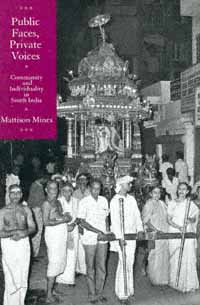 | Title: Public faces, private voices: community and individuality in South India Author: Mines, Mattison 1941- Published: University of California Press, 1994 Subjects: Anthropology | Cultural Anthropology | South Asia Publisher's Description: Individuality is often viewed as an exclusively Western value. In non-Western societies, collective identities seem to eclipse those of individuals. These generalities, however, have overlooked the importance of personal uniqueness, volition, and achievement in these cultures. As an anthropologist in Tamil Nadu, South India, Mattison Mines found private and public expressions of self in all sectors of society. Based on his twenty-five years of field research, Public Faces, Private Voices weaves together personal life stories, historical description, and theoretical analysis to define individuality in South Asia and to distinguish it from its Western counterpart.This engaging and controversial book will be of great interest to scholars and students working in anthropology, psychology, sociology, South Asian history, urban studies, and political science. [brief] Similar Items |
| 14. | 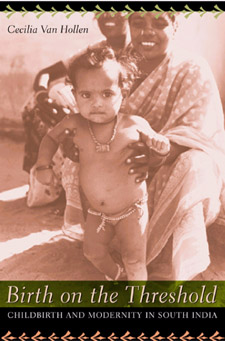 | Title: Birth on the threshold: childbirth and modernity in South India Author: Van Hollen, Cecilia Coale Published: University of California Press, 2003 Subjects: Anthropology | Cultural Anthropology | Medical Anthropology | Sociology | Gender Studies | Hinduism | South Asia | Asian Studies | South Asia | South Asia Publisher's Description: Even childbirth is affected by globalization - and in India, as elsewhere, the trend is away from home births, assisted by midwives, toward hospital births with increasing reliance on new technologies. And yet, as this work of critical feminist ethnography clearly demonstrates, the global spread of biomedical models of childbirth has not brought forth one monolithic form of "modern birth." Focusing on the birth experiences of lower-class women in the South Indian state of Tamil Nadu, Birth on the Threshold reveals the complex and unique ways in which modernity emerges in local contexts. Through vivid description and animated dialogue, this book conveys the birth stories of the women of Tamil Nadu in their own voices, emphasizing their critiques of and aspirations for modern births today. In light of these stories, author Cecilia Van Hollen explores larger questions about how the structures of colonialism and postcolonial international and national development have helped to shape the form and meaning of birth for Indian women today. Ultimately, her book poses the question: How is gender - especially maternity - reconfigured as birth is transformed? [brief] Similar Items |
| 15. | 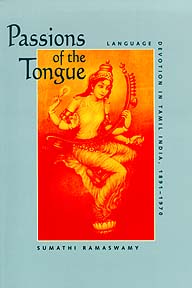 | Title: Passions of the tongue: language devotion in Tamil India, 1891-1970 Author: Ramaswamy, Sumathi Published: University of California Press, 1997 Subjects: Asian Studies | History | South Asia | Language and Linguistics | Asian History | Asian Literature Publisher's Description: Why would love for their language lead several men in southern India to burn themselves alive in its name? Passions of the Tongue analyzes the discourses of love, labor, and life that transformed Tamil into an object of such passionate attachment, producing in the process one of modern India's most intense movements for linguistic revival and separatism. Sumathi Ramaswamy suggests that these discourses cannot be contained within a singular metanarrative of linguistic nationalism and instead proposes a new analytic, "language devotion." She uses this concept to track the many ways in which Tamil was imagined by its speakers and connects these multiple imaginings to their experience of colonial and post-colonial modernity. Focusing in particular on the transformation of the language into a goddess, mother, and maiden, Ramaswamy explores the pious, filial, and erotic aspects of Tamil devotion. She considers why, as its speakers sought political and social empowerment, metaphors of motherhood eventually came to dominate representations of the language. [brief] Similar Items |
| 16. | 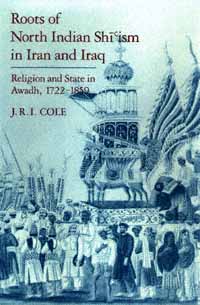 | Title: Roots of North Indian Shīʿism in Iran and Iraq: religion and state in Awadh, 1722-1859 Author: Cole, Juan Ricardo Published: University of California Press, 1989 Subjects: Asian Studies Publisher's Description: In this pioneering study of the Twelver Shi'i branch of Islam prevalent in Iraq and Iran, J. R. I. Cole traces the influence of Shi'i rule on the development of religious communalism and conflict in the North Indian State of Awadh (Oudh). He also examines the relationship of the Shi'i clergy to the state and the clerical reaction to British imperialism and capitalism.Based on research in rare manuscripts and in archives, the book reveals that the Shi'i clergy advocated policies that caused resentment among Sunnis and Hindus, thereby promoting religious communalism and setting the stage for modern communal conflict. The Shi'i learned men took government posts in support of Awadh's Shi'i nawabs and shahs; Awadh state support, in turn, helped transform Shi'ism from a persecuted "sect" to a dominant, if still minority, religious establishment.Sociologically, the book draws attention to the specific role of the state in defining "sect" and "church." It also argues the importance of class divisions within the Shi'i community, showing that the dominant clerical ideology was often not accepted by the laboring strata. Cole's study supports the view that Muslim communalism in Northern India had genuine historical roots and was not simply an elite strategy of modern Muslim politicians. Contrary to the arguments of some writers and to the image projected by Iran's current ayatullahs, he claims that most Shi'i clergy did not play a role of opposition to the state. [brief] Similar Items |
| 17. | 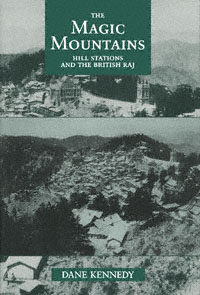 | Title: The magic mountains: hill stations and the British raj Author: Kennedy, Dane Keith Published: University of California Press, 1996 Subjects: History | Asian History | European History | South Asia Publisher's Description: Perched among peaks that loom over heat-shimmering plains, hill stations remain among the most curious monuments to the British colonial presence in India. In this engaging and meticulously researched study, Dane Kennedy explores the development and history of the hill stations of the raj. He shows that these cloud-enshrouded havens were sites of both refuge and surveillance for British expatriates: sanctuaries from the harsh climate as well as an alien culture; artificial environments where colonial rulers could nurture, educate, and reproduce themselves; commanding heights from which orders could be issued with an Olympian authority.Kennedy charts the symbolic and sociopolitical functions of the hill stations over the course of the nineteenth and early twentieth centuries, arguing that these highland communities became much more significant to the British colonial government than mere places for rest and play. Particularly after the revolt of 1857, they became headquarters for colonial political and military authorities. In addition, the hill stations provided employment to countless Indians who worked as porters, merchants, government clerks, domestics, and carpenters.The isolation of British authorities at the hill stations reflected the paradoxical character of the British raj itself, Kennedy argues. While attempting to control its subjects, it remained aloof from Indian society. Ironically, as more Indians were drawn to these mountain areas for work, and later for vacation, the carefully guarded boundaries between the British and their subjects eroded. Kennedy argues that after the turn of the century, the hill stations were increasingly incorporated into the landscape of Indian social and cultural life. [brief] Similar Items |
| 18. | 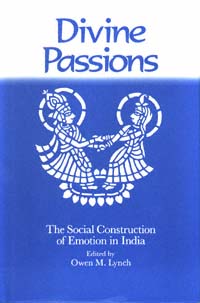 | Title: Divine passions: the social construction of emotion in India Author: Lynch, Owen M 1931- Published: University of California Press, 1990 Subjects: Anthropology | South Asia | History Publisher's Description: Naked holy men denying sexuality and feeling; elderly people basking in the warmth and security provided by devoted and attentive family members; fastidious priests concerned solely with rules of purity and minutiae of ritual practice; puritanical moralists concealing women and sexuality behind purdah's veils - these are familiar Western stereotypes of India. The essays in Divine Passions , however, paint other, more colorful and emotionally alive pictures of India: ecstatic religious devotees rolling in temple dust; gray-haired elders worrying about neglect and mistreatment by family members; priests pursuing a lusty, carefree ideal of the good life; and jokers reviling one another with bawdy, sexual insults at marriages.Drawing on rich ethnographic data from emotion-charged scenarios, these essays question Western academic theories of emotion, particularly those that reduce emotions to physiological sensations or to an individual's private feelings. Presenting an alternative view of emotions as culturally constructed and morally evaluative concepts grounded in the bodily self, the contributors to Divine Passions help dispel some of the West's persistent misconceptions of Indian emotional experience. Moreover, the edition as a whole argues for a new and different understanding of India based on field research and an understanding of the devotional (bhakti) tradition. [brief] Similar Items |
| 19. | 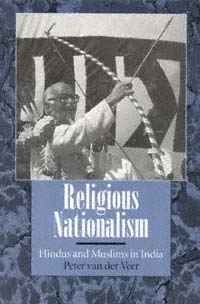 | Title: Religious nationalism: Hindus and Muslims in India Author: Veer, Peter van der Published: University of California Press, 1994 Subjects: Anthropology | Cultural Anthropology | Hinduism | South Asia Publisher's Description: Religious nationalism is a subject of critical importance in much of the world today. Peter van der Veer's timely study on the relationship between religion and politics in India goes well beyond other books on this subject. He brings together several disciplines - anthropology, history, social theory, literary studies - to show how Indian religious identities have been shaped by pilgrimage, migration, language development, and more recently, print and visual media.Van der Veer's central focus is the lengthy dispute over the Babari mosque in Ayodhya, site of a bloody confrontation between Hindus and Muslims in December 1992. A thought-provoking range of other examples describes the historical construction of religious identities: cow protection societies and Sufi tombs, purdah and the political appropriation of images of the female body, Salman Rushdie and the role of the novel in nationalism, Mahatma Gandhi and Swami Vivekananda, the Khalsa movement among Sikhs, and nationalist archaeology and the televised Ramayana .Van der Veer offers a new perspective on the importance of religious organization and the role of ritual in the formation of nationalism. His work advances our understanding of contemporary India while also offering significant theoretical insights into one of the most troubling issues of this century. [brief] Similar Items |
| 20. | 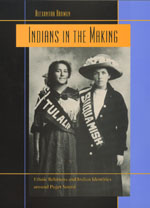 | Title: Indians in the making: ethnic relations and Indian identities around Puget Sound Author: Harmon, Alexandra 1945- Published: University of California Press, 1999 Subjects: Native American Studies | United States History | Ethnic Studies | California and the West Publisher's Description: In the Puget Sound region of Washington state, indigenous peoples and their descendants have a long history of interaction with settlers and their descendants. Indians in the Making offers the first comprehensive account of these interactions, from contact with traders of the 1820s to the Indian fishing rights activism of the 1970s. In this thoroughly researched history, Alexandra Harmon also provides a theoretically sophisticated analysis that charts shifting notions of Indian identity, both in native and in nonnative communities.During the period under consideration, each major shift in demographic, economic, and political conditions precipitated new deliberations about how to distinguish Indians from non-Indians and from each other. By chronicling such dialogues over 150 years, this groundbreaking study reveals that Indian identity has a complex history. Examining relations in various spheres of life - labor, public ceremony, marriage and kinship, politics and law - Harmon shows how Indians have continually redefined themselves. Her focus on the negotiations that have given rise to modern Indian identity makes a significant contribution to the discourse of contemporary multiculturalism and ethnic studies. [brief] Similar Items |